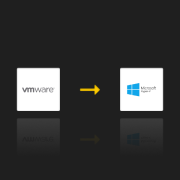
The power of metadata
Virtual environment create a real headache? End it with the snap of a finger – that’s what technology is for.
Our new Xopero Image Tool (free and stand-alone application) allows fast image conversion to any other format supported by popular hypervisors like Hyper-V, VMware, Virtualbox and KVM. This way users can convert RAW files to VHD, VMDK and VHDX and back. XIT also allows to move physical machine to any virtual environment – and makes P2V (physical-to-virtual) conversion really easy. Furthermore by resetting registry entries it can solve technical problems during the reboot of the machine.
What’s so special about this?
They are many pros of virtualization for example it eliminates the need to invest in a large number of hardware. By providing such flexibility and scalability it can really help constantly growing companies. However, virtualized environments have some drawbacks too. One of the most painful aspects is moving existing VM to other environment – and in particular a large amount of time it usually takes.
That’s why rather than creating a new one it is more efficient to convert existing VM image to another format. But what would you say if you could do that in seconds? Or even better – in 0.27 seconds? Time plays a key part in every business success. That’s why we asked ourselves how we [Xopero] could make it better?
Xopero makes difference
Image formats have many differences, but at least one similarity – they always have some information about data stored in a file container. While still working on a conversion library our team noticed that some image formats can be converted much faster than the other ones. Why is that? Formats like VHD had metadata information stored at the end of a file. VMDK is an unique example because it can store metadata information with a linked data file. We used this new knowledge to create Xopero Image Tool and this is why users can convert a VHD to RAW or RAW to VHD format so quickly. XIT just writes or deletes metadata at the end of file while converting the image. Users can also create a VMDK just in 1 second – using RAW image as a data container.
„Reliable data protection is critical especially while there is so many potential risks that threaten modern business on daily basis. And as a modern backup provider we recognized that our customers will require from us to do more. In 2017 our team started some serious research about virtualization technology. And I can openly say that this investment pays off. Today we are delivering a brand new solution which allows extra fast image conversion. And it’s 100% free. There is also a SVS [Smart Virtualization Stick], our special technology which gives a simple pendrive a superpowers to restore whole devices or systems extremely fast. Just these two tools change the way which IT Admins can manage virtualized data – or resource in general. This is also the direction of our main development. You can expect more/similar releases in next months.” – said Luke Jesis, CEO at Xopero Software.
The power of metadata
During Xopero HDD backup restore a .met file is created (metadata), which provides a flexible format that can be converted into most popular ones next. The metadata file contains information about partition layout, style, disk usage, sector size, and default registry drivers that should be loaded before Windows starts. These parameters are used by Xopero Image Tool to create other image formats’ metadata and to edit system registry keys and start the machine without any problems.
Other formats like VHDX could have metadata information in different places, for example at the beginning of the file. This causes serious problem – to save metadata file should be copied first. That’s why not every format could be created “in-place”.
First version of XIT converts images that were created in a fixed size mode. Dynamic images conversion is not supported. But if the machine has fixed size images, users are able to use the tool without any restrictions
The main functionality is to convert the HDD Image format to three most popular ones – VHD, VHDX and VMDK. This way users can create a VM configuration with converted backup image in Hyper-V, VMware, VirtualBox and KVM. In addition they can also use the physical computer image, what makes P2V conversion really easy.







